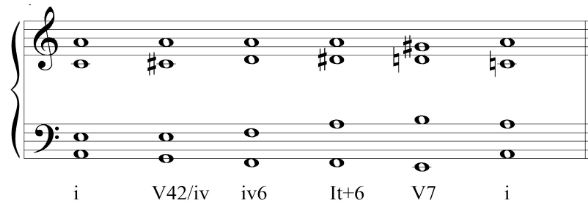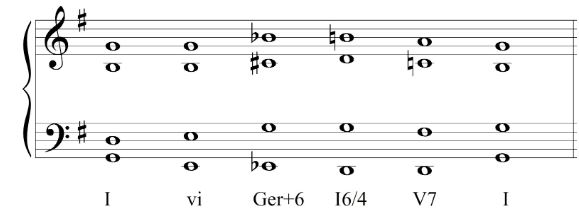Integrated Aural Skills 2018-19
Introduction to Augmented Sixth Chords
Definitions
Augmented sixth chords are called this because they are bordered by the interval of an augmented sixth between le and fi.
There are three types of augmented sixth chord:
- Italian sixth (le-do-fi), commonly analyzed using the abbreviation It+6
- French sixth (le-do-re-fi), abbreviated Fr+6
- German sixth (le-do-me-fi), abbreviated Ger+6
In Context - Piano Practice
Play the following cadential progressions on the piano, taking careful notice of the solfege degrees and voice-leading. How do the chords resolve? Experiment: try to make one type of augmented sixth chord into another type. How does this affect the voice-leading?
Theory - Harmonic Function
Augmented sixth chords typically precede the dominant. For voice-leading reasons (i.e. avoiding parallel perfect consonances), i 6/4 will come between the augmented sixth and the dominant (though, as you know, the cadential 6/4 itself has dominant function.) This is particularly true when the chord in question is a German sixth chord.
Theory - Voice-Leading Procedure
When the augmented sixth precedes V, le typically resolves down to sol, and fi typically resolves upwards to sol. But when the augmented sixth chord precedes V7, fi can resolve downwards to fa.
Ear Training - Tips for IDing in Harmonic Dictation
- All augmented sixth chords: listen for le (resolving to sol on the next chord) in the bass voice.
- The Italian sixth only has 3 tones; therefore, color is much less “rich” than the other two types of augmented sixth chord. It is common to confuse the Italian and German sixth chords, so be sure to practice them both on the piano until you can differentiate their colors confidently.
- The French sixth sounds very dissonant because it’s composed of a partial whole-tone collection. Listen for the “impressionistic” tone color that we associate with the whole-tone scale. The French sixth is also a symmetrical chord, being composed of two major thirds separated by a major second.
- The German sixth chord is easily confused with the Italian sixth, but it is a much richer chord because it has 4 tones. Note: the German sixth chord has the same pitch classes as a major-minor chord in root position (Mm7), but of course it has a different function and different enharmonic spelling.
In Context - More Piano Practice
- In this Italian sixth chord, do is doubled (since the Italian sixth chord only has 3 tones, and do, being the most “stable” tone, is the logical doubling choice). Experiment: what would happen if you changed the tenor voice to re or me to form a French or German sixth chord? Play around with the chords at the piano to see how you can use different types of augmented sixth chords to change the color of the harmony.
- In this example, the German sixth chord is followed by i 6/4 (to avoid parallel perfect fifths). This presentation is common for reasons of good voice-leading. Notice how le resolves to sol in the bass as usual, but fi (in the alto voice) resolves upwards to sol.
In Context - Singing
- Prepare this material carefully, because it will be in the elements section of the final audit. Experiment: can you perform the exercises in a variety of different keys?




